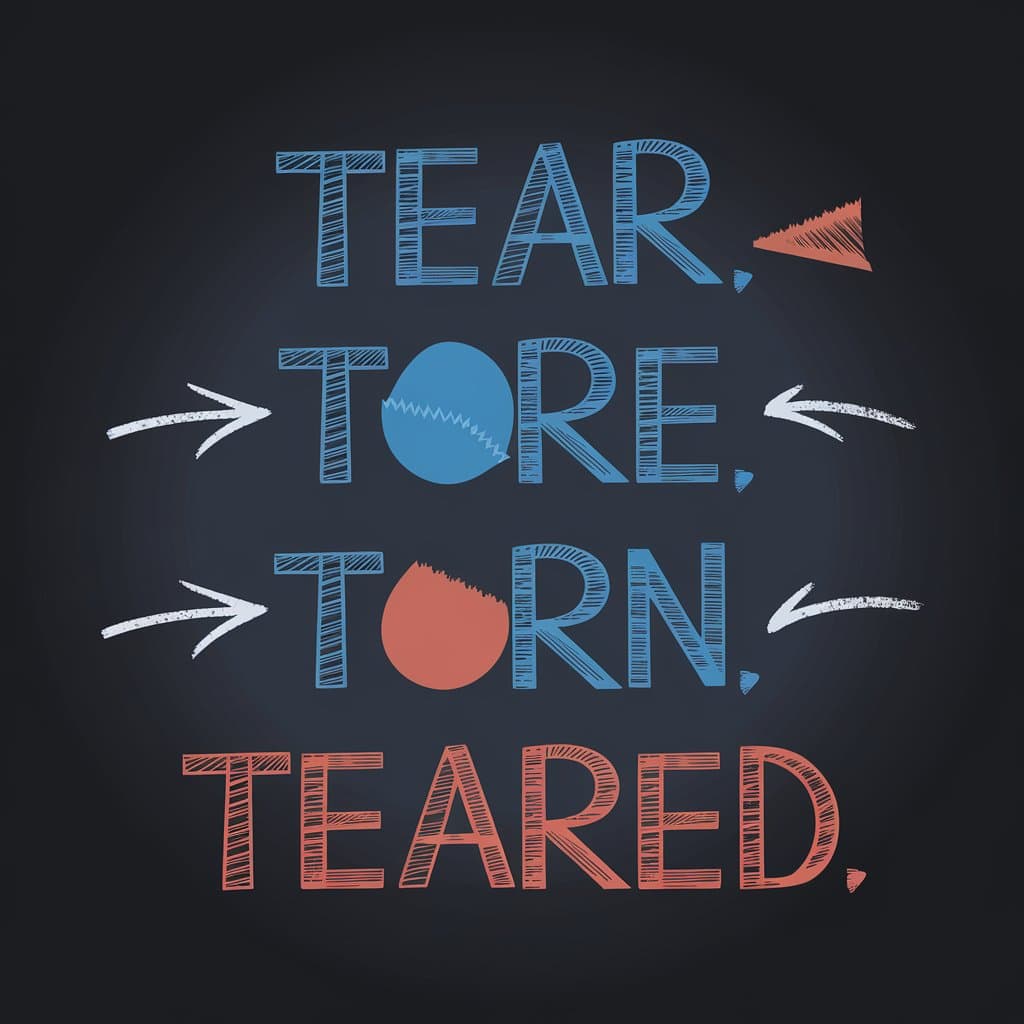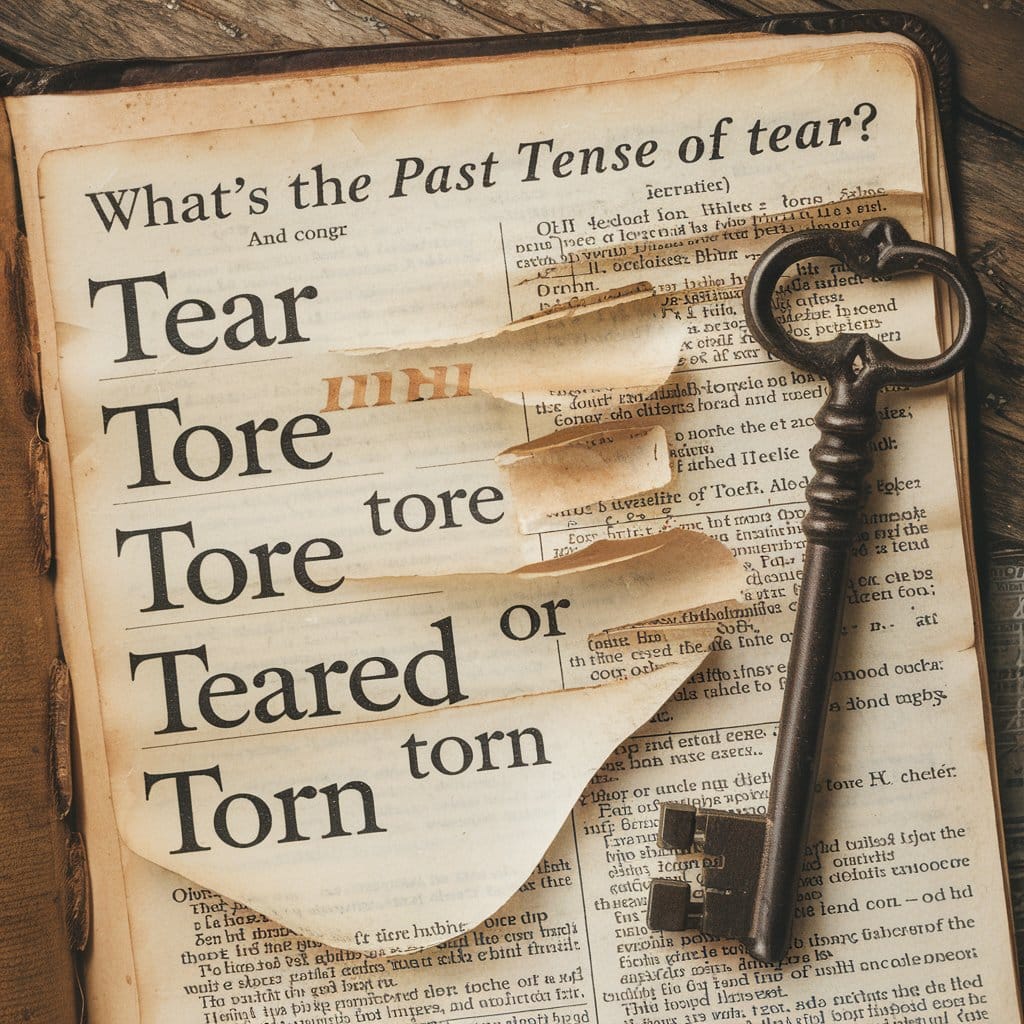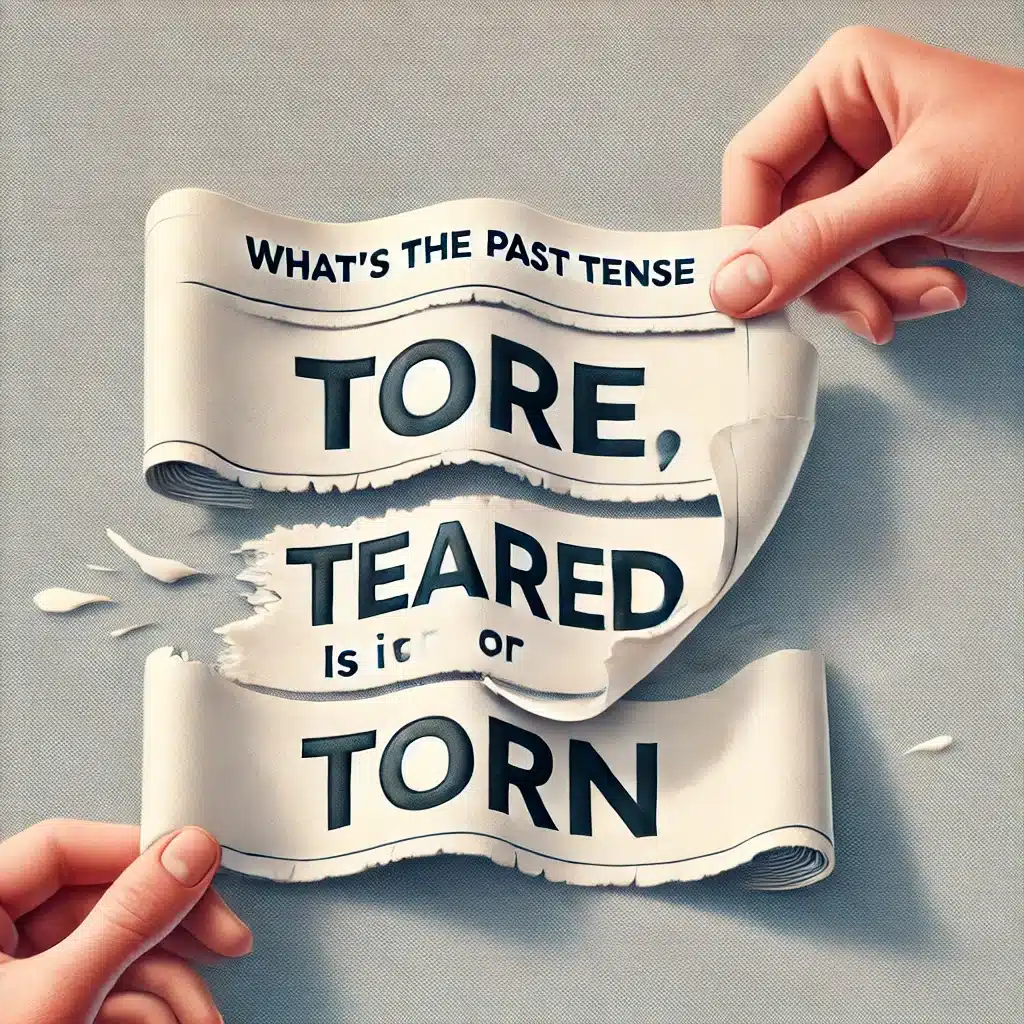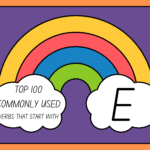Understanding the correct past tense of the word “tear” can be tricky. Is it tore, teared, or torn? These forms can create confusion, especially because “tear” has multiple meanings. Whether you’re talking about ripping paper, crying, or even tearing down a building, the past tense of “tear” varies based on its usage.
This comprehensive guide will clarify the correct past tense forms, their pronunciation, and how to use them in sentences. We’ll also explore some of the common confusions that arise when using this word and break down the meaning behind various phrases and verbs.
Why Is There Confusion?
The confusion around the word tear often stems from its dual meaning. On one hand, tear can mean to rip or pull something apart violently (like tearing paper), and on the other hand, it can mean to shed tears, as in crying. Both meanings have different past tenses, which causes some people to misuse or misunderstand the correct forms.
- Tear (To rip or pull apart) uses the past tense tore and the past participle torn. For example, “He tore the paper” or “The fabric has been torn.”
- Tear (To cry or shed tears) uses the past tense teared. For example, “She teared up when she heard the sad news.”
Because of this dual nature, it’s easy to mix up these past forms when writing or speaking. Let’s break down the meaning of each variation of the word tear to make it clearer.
What Does the Word “Tear” Mean?
Before diving into the past tense of “tear,” let’s review the different meanings of the word. The verb tear and its noun form refer to multiple things, each with its own grammatical rules.
(Verb – To rip or pull apart by force)
- Definition: To damage or separate something by pulling it apart or into pieces.
- Example: “I tear the paper when I’m frustrated.”
- Use Case: Common in both spoken and written English when referring to physical objects like paper, fabric, or materials that can be ripped.
(Verb – To cry or shed tears)
- Definition: To shed tears due to emotional responses like sadness, joy, or pain.
- Example: “She tears up whenever she watches sad movies.”
- Use Case: Used to describe the emotional act of crying, usually with softer verbs like “teared up.”
(Noun – A drop of fluid from the eye)
- Definition: The salty fluid that flows from your eyes when crying.
- Example: “A tear rolled down her cheek as she said goodbye.”
- Use Case: Refers to the actual physical liquid that comes from the eyes when a person cries.
(Noun – A rip or laceration)
- Definition: A physical split or rupture in something, such as a tear in fabric.
- Example: “There’s a tear in my shirt where it caught on the fence.”
- Use Case: Used to describe damage to materials or surfaces.
(Verb – To move noisily or quickly)
- Definition: To move rapidly with force, often making a loud noise.
- Example: “The car tore down the street at high speed.”
- Use Case: Less common, but used to describe fast, noisy motion.
Read more : What’s the Plural of Hippopotamus? Is it Hippopotamuses?
The Past Tense of “Tear” (To Rip)
For the meaning of tear that refers to ripping or pulling apart by force, the past tense and past participle forms are straightforward.
Present Tense: “Tear”
- Example: “I tear the wrapping paper every Christmas.”
Simple Past Tense: “Tore”
- Example: “Yesterday, I tore the wrapping paper too quickly.”
The past tense of “tear” in this sense is tore, which refers to the action of ripping something in the past. It is also used when expressing frustration or anger, such as “He tore his homework when he couldn’t solve the problem.”
Past Participle: “Torn”
- Example: “The dress was torn after I caught it on a nail.”
The past participle form torn is used with auxiliary verbs such as “has” or “have.” It describes something that has been ripped or pulled apart in the past but still affects the present. For example, “The book has been torn” or “The flag was torn during the storm.”
The Past Tense of “Tear” (To Cry)
When we use tear to refer to shedding tears, the past tense form changes.
Present Tense: “Tear” (Shedding Tears)
- Example: “She often tears up at weddings.”
Simple Past Tense: “Teared”
- Example: “She teared up when she heard the news of his promotion.”
Unlike the past tense for ripping (tore), the past tense of tear (to cry) is teared. This form is less commonly used, but it’s correct when referring to crying. For example, “He teared up during the speech.”
Past Participle: Not Applicable
There is no common past participle for teared in the crying sense. We simply use teared for past tense expressions related to crying.
You may also like : Afterward vs Afterwards: Is There any Difference?
Pronunciation of “Tear,” “Tore,” “Torn,” and “Teared”

The pronunciation of tear, tore, torn, and teared varies based on their meanings, which can sometimes lead to confusion in both spoken and written English. Below, we’ll break down the correct pronunciation for each word and highlight the differences between their various uses.
Tear (To rip or pull apart by force)
- Pronunciation: /tɛr/
- Rhymes with: “air,” “care,” “bear”
- Example: “I will tear the paper in half.”
When tear is used in the sense of ripping or pulling apart, it is pronounced with a long “e” sound, similar to words like “air” or “hair.” This is the most common pronunciation when you’re referring to physically damaging or separating something.
Tear (To cry or shed tears)
- Pronunciation: /tɪr/
- Rhymes with: “peer,” “dear,” “fear”
- Example: “She always tears up during sad movies.”
When referring to crying, tear is pronounced with a short “i” sound, as in “peer” or “near.” This is a softer sound and is always associated with the emotional act of crying or shedding tears.
Tore (Simple past of tear, to rip)
- Pronunciation: /tɔːr/
- Rhymes with: “bore,” “more,” “store”
- Example: “Yesterday, I tore the letter into pieces.”
Tore is the simple past form of tear (to rip) and is pronounced with an “or” sound, similar to words like “door” or “floor.” This form is always used when describing the action of ripping or tearing something in the past.
Torn (Past participle of tear, to rip)
- Pronunciation: /tɔːrn/
- Rhymes with: “born,” “corn,” “mourn”
- Example: “The fabric has been torn for years.”
Torn is the past participle form of tear (to rip), used in sentences that require a completed action, usually with auxiliary verbs like has or have. It shares the same “or” sound as tore, but the additional “n” at the end makes it rhyme with words like “worn” and “scorn.”
Teared (Past tense of tear, to cry)
- Pronunciation: /tɪrd/
- Rhymes with: “feared,” “steered,” “cleared”
- Example: “She teared up when she heard the sad news.”
When tear is used in the sense of crying, the past tense teared is pronounced similarly to the word “feared.” The “eared” sound comes from its association with crying, distinguishing it from tore or torn, which refer to the act of ripping.
Why Pronunciation Matters
Pronunciation plays a critical role in effective communication, especially in the English language, where many words can sound alike yet have entirely different meanings. Understanding the importance of pronunciation can enhance clarity, improve comprehension, and foster better relationships in both personal and professional settings. Let’s explore why pronunciation matters in greater detail.
1. Avoiding Miscommunication
Mispronouncing words can lead to significant misunderstandings. For instance, consider the words tear (to rip) and tear (a drop of liquid from the eye). If someone says, “I will tear up during the movie,” using the wrong pronunciation could confuse listeners about whether they mean to rip something or cry.
- Example: If someone asks, “Did you tear the paper?” and you respond, “No, I teared,” it can create confusion about whether you are referring to ripping or crying, leading to a miscommunication of your actions or feelings.
2. Establishing Credibility and Professionalism
In professional environments, clear pronunciation reflects attention to detail and knowledge of the subject matter. Poor pronunciation can undermine your credibility and lead others to question your expertise.
- Example: A job interview is an excellent opportunity to showcase your skills and knowledge. However, if you mispronounce industry-specific terminology, it may give the impression that you lack competence or preparation.
3. Enhancing Comprehension
Listeners rely on pronunciation to understand the speaker’s message. Correct pronunciation aids in comprehension, allowing listeners to grasp complex ideas quickly.
- Example: In academic discussions, precise pronunciation helps convey the intended message without ambiguity. Mispronounced words can lead to confusion, especially in nuanced topics like scientific or technical discussions.
4. Building Rapport and Connection
Effective communication is vital in building relationships, whether personal or professional. Using the correct pronunciation fosters a sense of connection and understanding between individuals.
- Example: In social settings, accurately pronouncing someone’s name or the names of common terms creates a more inviting atmosphere. It shows that you value the conversation and respect the other person, which can strengthen your relationship.
5. Language Acquisition and Learning
For language learners, mastering pronunciation is essential for developing fluency. Incorrect pronunciation can hinder progress and make learners hesitant to speak, leading to missed opportunities for practice and engagement.
- Example: When learning English, mispronouncing key verbs like tear, tore, and torn can create anxiety for non-native speakers. They might avoid using these words altogether, limiting their vocabulary and hindering their ability to express themselves fully.
6. Navigating Regional Variations
English is spoken globally, with numerous dialects and regional accents. Understanding pronunciation helps navigate these differences and communicate effectively with speakers from various backgrounds.
- Example: The word torn may sound different in British English versus American English, yet the meaning remains the same. Being aware of these regional variations can enhance your adaptability in diverse environments.
7. Language Nuances and Context
Pronunciation often adds nuance to language that can change the context of a conversation. Understanding how to pronounce words based on their usage can help convey the intended emotion or seriousness of a situation.
- Example: In literature, when characters express emotions through the word tear, using the correct pronunciation conveys the gravity of the moment, enhancing the reader’s or listener’s connection to the narrative.
8. Encouraging Clear Communication in Teams
In a team setting, clear pronunciation fosters effective collaboration. Misunderstandings due to pronunciation can lead to errors in projects or tasks, impacting overall productivity.
- Example: In a team meeting, clearly articulating terms and action items ensures everyone is on the same page. It minimizes the risk of miscommunication, which can result in project delays or errors.
Quick Pronunciation Reference Chart
| Word | Meaning | Pronunciation | Rhymes with |
| Tear (rip) | To rip or pull apart | /tɛr/ | air, care, bear |
| Tear (cry) | To shed tears | /tɪr/ | peer, dear, fear |
| Tore | Simple past of tear (rip) | /tɔːr/ | bore, more, store |
| Torn | Past participle of tear (rip) | /tɔːrn/ | born, worn, mourn |
| Teared | Past tense of tear (cry) | /tɪrd/ | feared, cleared, steered |
By recognizing these subtle differences in pronunciation, you can communicate more effectively and avoid misunderstandings in both speech and writing.
Verb Conjugation Table: The Present, Past, and Future Tense of “Tear”
Here’s a simple table that illustrates how the verb tear conjugates based on its meanings (to rip vs. to cry):
| Verb Form | Tear (To Rip) | Tear (To Cry) |
| Present | Tear | Tear |
| Past | Tore | Teared |
| Past Participle | Torn | (Not applicable) |
| Future | Will tear | Will tear |
Examples in Sentences
Tear (Present Tense)
- To Rip: “I tear the paper into tiny pieces.”
- To Cry: “She often tears up during sad scenes in movies.”
Tore (Simple Past Tense)
- To Rip: “He tore the document in frustration.”
- To Cry: “She teared up when she heard the good news.”
Torn (Past Participle)
- To Rip: “The fabric has been torn for a while now.”
Teared (Past Tense for Crying)
- To Cry: “He teared up when they surprised him with a birthday party.”
Synonyms for “Tear,” “Tore,” “Torn,” and “Teared”
Having a variety of synonyms can help you avoid repetition in writing. Here are some common synonyms for each form of tear:
“Tear” (Present tense, to rip)
- Rip
- Split
- Rend
- Shred
“Tore” (Simple past tense, to rip)
- Ripped
- Split
- Rent
- Sundered
“Torn” (Past participle, to rip)
- Shredded
- Sundered
- Ripped
“Teared” (Past tense for crying)
- Wept
- Sobbed
- Cried
- Blubbered
The Origins of the Word “Tear”

Etymology gives us insight into why tear has multiple forms and uses. The verb tear (to rip) and the noun tear (fluid from the eyes) come from different Old English roots, despite being spelled the same in modern usage.
Etymology of “Tear” (To Rip)
- The verb tear comes from the Old English word teran, meaning “to rend or pull apart.” Its usage dates back to early Germanic languages and has been consistent in meaning since its origins.
Etymology of “Tear” (To Cry)
- The noun tear (as in crying) comes from the Old English word tǣr, which means “a drop of fluid from the eye.” It has been used in this context for centuries, evolving in meaning alongside the emotional connotations we associate with crying.
The Noun and Verb Forms of “Tear”
Beyond verbs, tear also has noun forms with distinct meanings. Let’s clarify them:
The Noun “Tear” (The fluid drop from the eye)
- Definition: The salty fluid that comes from the eyes when someone cries.
- Example: “A tear fell down her cheek.”
The Verb “Tear” (To rend or pull apart by force)
- Definition: The act of ripping or pulling something apart.
- Example: “I will tear the document if we can’t agree.”
The Verb “Tear” (To cry or weep)
- Definition: The act of shedding tears.
- Example: “He teared up when he received the good news.”
The Noun “Tear” (A tear or laceration)
- Definition: A rip or physical split in an object, such as fabric.
- Example: “The jacket has a tear near the pocket.”
The Verb “Tear” (To move noisily or quickly)
- Definition: To move rapidly, often with noise.
- Example: “The motorbike tore down the road at high speed.”
Final Clarification: “Tore” vs. “Teared”
Let’s recap:
- “Tore” is used when something has been ripped or pulled apart. Example: “He tore the letter.”
- “Teared” is used when referring to crying. Example: “She teared up during the emotional scene.”
It’s essential to remember that the context of the word tear determines which past tense you should use. Additionally, the verb torn only applies to the ripping sense of the word, and not to crying.
A Final Look at the Past Tense of “Tear”
In summary, tear can have different meanings, and the correct past tense depends on how the word is used.
- For ripping or pulling apart: Use tore in the simple past tense and torn as the past participle.
- For crying: Use teared in the past tense when referring to shedding tears.
The flexibility of tear as a word illustrates the complexity of the English language, but once you understand the different forms, you’ll be able to use it accurately and confidently. Just remember the context, and you’ll know whether to say tore, teared, or torn in any given sentence.
Also try this one : Arised or Arose: What’s the Correct Past Tense of Arise?
Sources
- Merriam-Webster Dictionary
- Oxford English Dictionary
- Cambridge English Grammar Guides

John David is an experienced blogger at Grammar Blend, passionate about language and communication. With a keen eye for grammar and clarity, he shares practical tips and tools to help readers improve their writing skills. His insightful articles make grammar accessible and engaging for learners of all levels.







